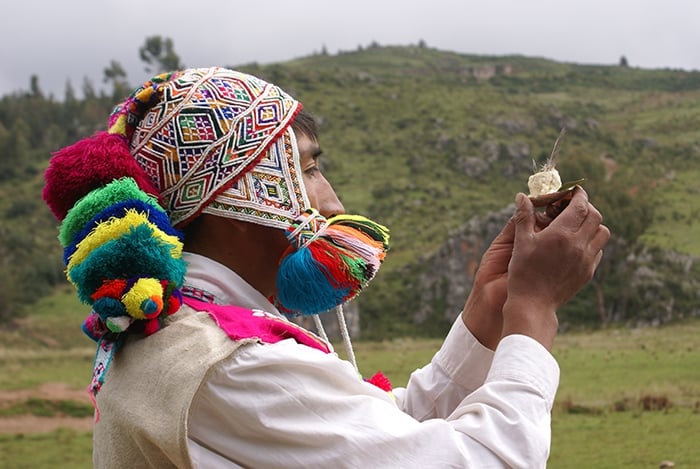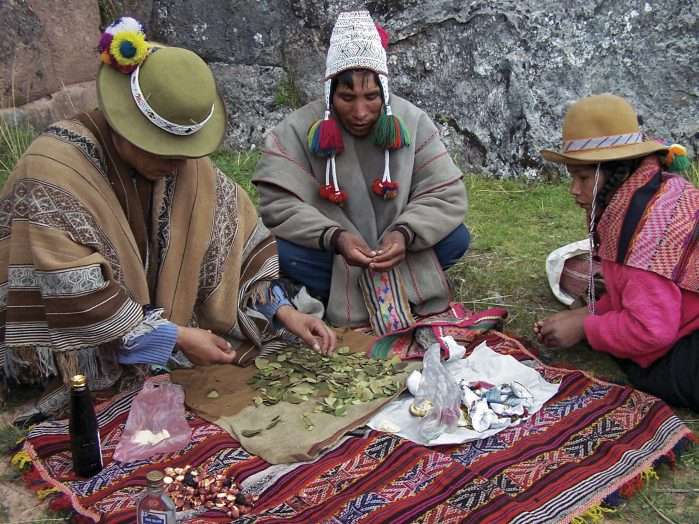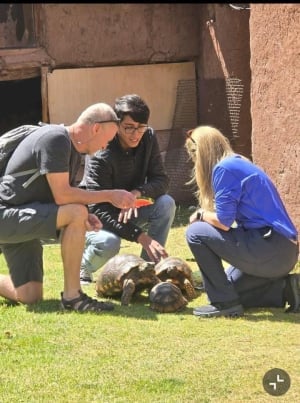Peru of Living Cultures
The ancient Peruvians developed strong links with nature based on respect, fear, and adoration. Men and animals depended exclusively on what the earth could produce and provide, and this led to the need to express their worship of the earth as a source of life. The religion of the Andean world had its roots in ancestral rites that linked men to his habitat. In the Andean view of the cosmos, the Inti, or Sun God, was one of the most important gods; the Apus were the spirits that lived in the guardian mountains and Mother Earth (Pachamama) was the goddess of fertility.
Seen from the Andean logic of reciprocity, the payments or 'pagapus', are a way of thanking those spirits in control of natural forces, by offering back the goods or benefits they were given. The offerings that are buried in Mother Earth include coca leaves, which, for the
Andean people, are mediators between nature and the human world; different grain seeds, un-worked silver, 'sullus' (Llama or sheep fetuses), 'chicha' (an alcoholic beverage made from maize), wine, animal fat, jams and 'huairuros' (red and black seeds said to have symbolic and magic powers).
The ceremony is known as “payment to the earth”, frequently enacted in the Peruvian Andes, began on the first day of August and continued all through that month. The peasants believed that during this time Pachamama was hungry and thirsty, and it was necessary to satisfy her, feed her and offer her the best food to give her strength and energy.
 Payment offered to the Earth
Payment offered to the Earth
Another form of offerings is the 'apachetas' or stacks of stones that hikers leave close to the Apus, as a sign of respect. In patron saint festivals or social gatherings, it is common to throw beer or chicha on the ground, simulating respect and payment for all the provisions supplied by nature for human consumption.
Lambayeque
The north is a region with an abundance of agricultural products due to the richness of its soils; this is why the ancient Peruvians that settled in that zone were grateful to Mother Nature. In Lambayeque, Sipán and Sicán men used to give offerings of coca, 'aguardiente' (a kind of brandy), and food so that their ancestral spirits would persuade the earth to continue being so fertile. The leader of the ceremony is known as the shaman, or 'payment.' He is said to have supernatural powers and to be able to communicate with the spirit world, allowing him to invoke his ancestors, the apus and deities of the mountains to ensure that Mother Earth carries on producing her bounty.
Huaraz
In Huaraz, what is offered to the earth is done in the open air, in the region's highest spots, in a peaceful environment and an atmosphere charged with the earth's energy. The Cordillera Blanca (White Range) has the highest number of local shamans, although they can also be found in the surrounding areas of Huascarán, Huandoy and
 Payments offered to the Earth
Chopilcalqui
Payments offered to the Earth
Chopilcalqui
The Cerro Sechín temple, west of Huaraz, is covered in iconographic sea drawings and references to rain cycles, which were scarce during difficult times of drought. The Shamans from Sechín go up into the mountains, to the lagoons that form at the base of the snow-capped peaks, and offer sacrifices. Sometimes they do it where the sea is at its roughest, begging for rain to water their crops.
Cuzco
In Cuzco, there are esoteric tour services that allow visitors to be part of the Ayahuasca ceremony, a cleansing ritual. A medical form must be completed previously. Ayahuasca is a traditional plant used by ancient Peruvians to heighten their levels of awareness and gain inner harmony. This is always done with the help of a spiritual guide or Shaman. This ceremony is performed at night and the liquid is swallowed until the person experiences visions and can explore how their life is interconnected with the cosmos, universe, and the earth. The effect of the potion lasts around 3 hours and is followed by a sensation of weariness that forces the traveler to rest until the following day. Given the nature of the ceremony, it is necessary to fill out a medical form in advance.
Puno
The ceremony of making offerings to Mother Earth (the Pachamama) is an Andean ritual that has been practiced from time immemorial on the Andean plateau by Andean priests or pacos. They raise their hands to greet the spirits of the mountains (Apus) and offer prayers to them at the four points of the compass.
 Payments offered to the Earth
Payments offered to the Earth
Each year, on the third Thursday in January on the island Amantaní, the ceremonial sites of Pachatata and Pachamama are the scene of the Andean religion's most fervent display. On the main day of the ceremony, the region’s population fixes their gaze on the Apus, accompanied by the sound of pinquillo flutes and drums as a tribute to the fruitfulness of the generous mother earth. To participate in the ceremony is to practice the art of gratitude.
The leaves of coca, a sacred ancestral plant with healing powers, have been used as food and medicine in our country since the days of our ancestors. They serve as an intermediary between the internal world represented by the guardian Apus and the Pachamama, and the external world of man.


 Payments offered to the Earth
Payments offered to the Earth 